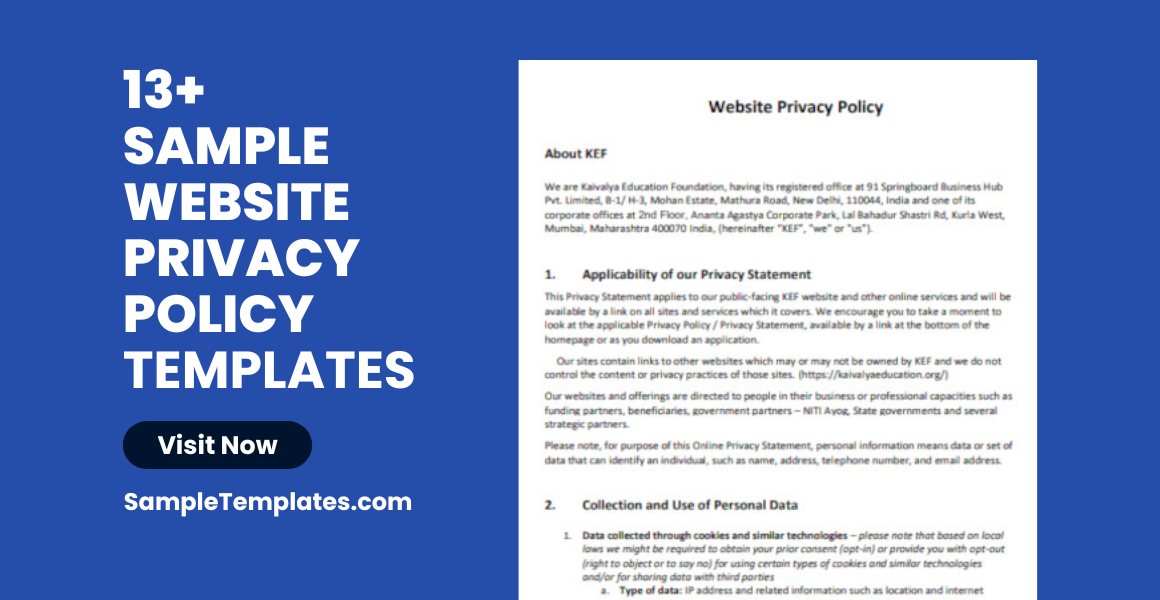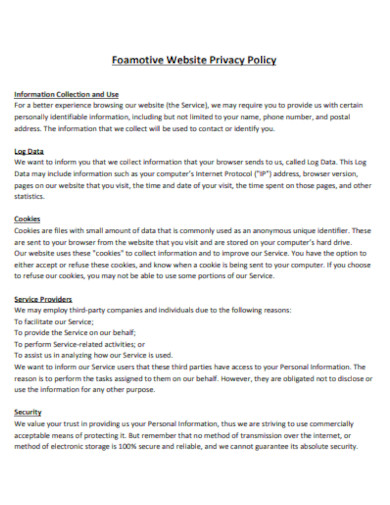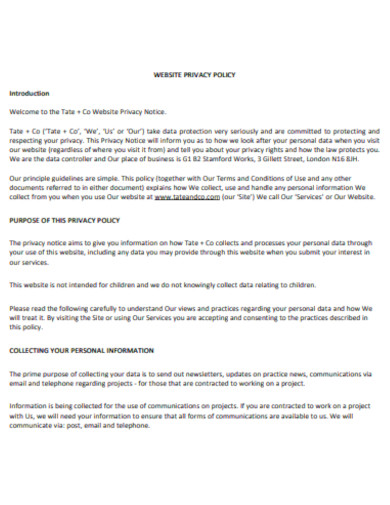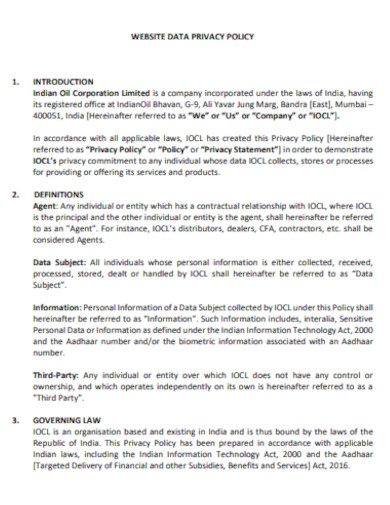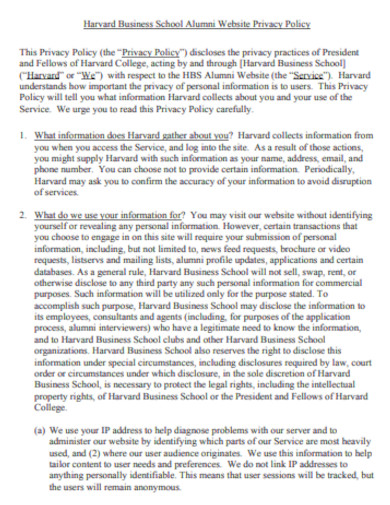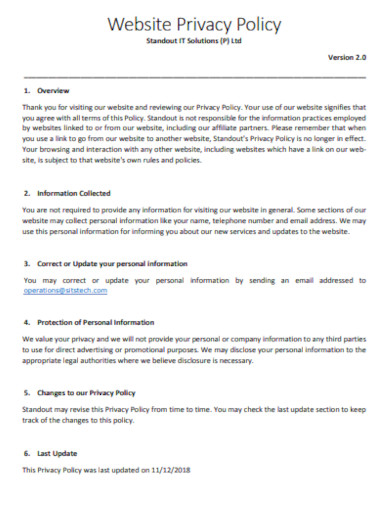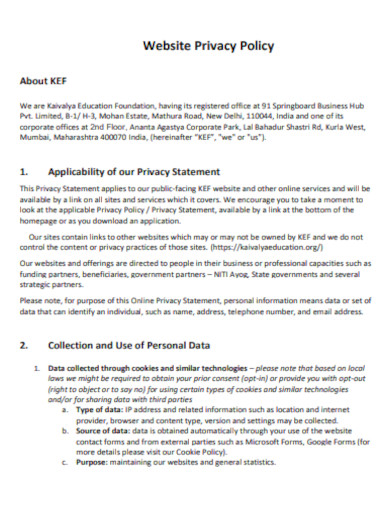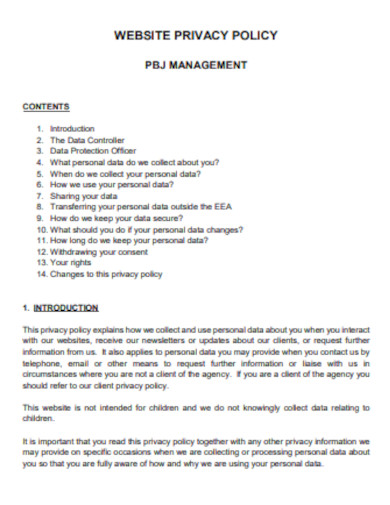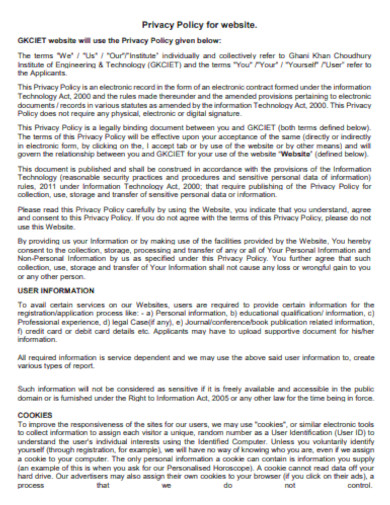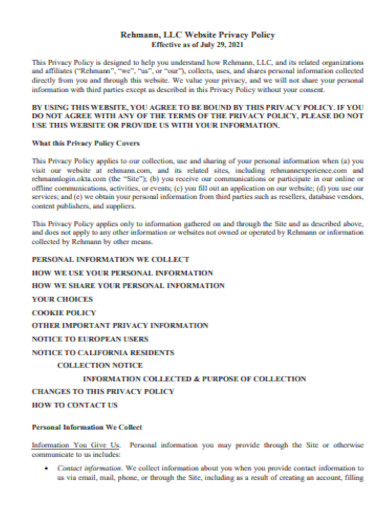Crafting a robust Website Privacy Policy is pivotal for safeguarding user data and building trust. This essential document sample outlines how personal information is collected, used, and protected. As online security concerns escalate, a transparent Privacy Policy reassures visitors, ensuring compliance with legal standards. Whether you’re a startup or an established enterprise, our guide simplifies creating a comprehensive policy tailored to your website’s needs, fostering a secure digital environment for your users.
13+ Website Privacy Policy Samples
1. Sample Webiste Privacy Policy Template

2. Sample Restaurant Website Privacy Policy Template
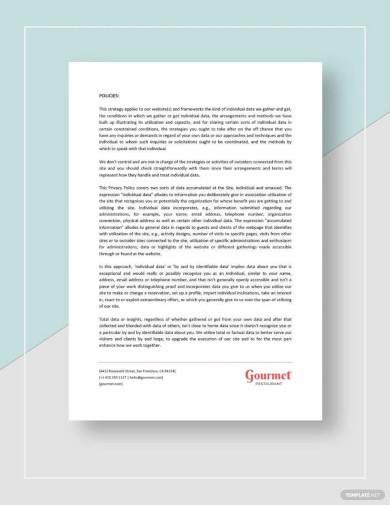
3. Sample Foamotive Website Privacy Policy Template
4. Sample Personal Website Privacy Policy Template
5. Sample Website Data Privacy Policy Template
What is a Website Privacy Policy?
In the digital age, a Website Privacy Policy has become a critical component for any online business or platform. It’s not just a legal requirement in many jurisdictions, but also a building block of trust between a website and its users. This document outlines how a website collects, uses, stores, and protects the data of its visitors and customers.
Understanding the Importance of a Privacy Policy
A Privacy Policy is more than just a legal safeguard; it’s a declaration of a website’s commitment to data protection. With increasing concerns over data breaches and identity theft, users look for transparency in how their information is handled. This sample policy serves as a communication tool, informing users about their rights and how they can expect their data to be treated.
Key Elements of a Privacy Policy
Every Privacy Policy should include several key elements to ensure clarity and compliance with applicable laws. These elements typically encompass:
- Information Collection: Detailing what types of personal information are collected, whether it’s done directly or through third parties.
- Usage of Information: Explaining how the collected information will be used. This could include site operation, personalization of content, or communication with users.
- Data Protection Measures: Describing the security measures in place to protect user data from unauthorized access or breaches.
- Cookies and Tracking Technologies: Clarifying the use of cookies and other tracking mechanisms, which are essential for personalized user experiences and analytics.
- Information Sharing: Outlining the circumstances under which information might be shared with third parties, such as for legal reasons or with service providers.
- User Rights: Informing users of their rights regarding their personal data, including access, correction, and deletion rights.
- Policy Updates: Notifying users about how they will be informed of any changes to the Privacy Policy.
Creating a Compliant Privacy Policy
Crafting a Privacy Policy that complies with various international laws like GDPR, CCPA, and others is crucial. It’s not just about legal compliance; it’s also about making sure that the policy is easily understandable to the average user. Using clear, concise language and avoiding legal jargon wherever possible makes the policy more user-friendly. You can also see more templates like Charity Privacy Policy Samples.
Examples of Privacy Policy in Action
To illustrate, let’s consider an e-commerce sample website. Such a site would collect personal information at checkout, including names, addresses, and payment information. The Privacy Policy would detail how this information is used to process orders, the security measures to protect this information, and how cookies are used to remember user preferences and items in the shopping cart.
Why Your Website Needs a Privacy Policy?
A Privacy Policy is not just a legal requirement for websites; it’s a fundamental component of online integrity and transparency. Here’s why your website, regardless of its size or industry, needs a comprehensive Privacy Policy.
Legal Compliance
- Laws and Regulations: Various laws around the world, such as the GDPR in Europe, CCPA in California, and others, require websites to have a Privacy Policy if they collect personal data.
- Avoiding Penalties: Non-compliance can lead to hefty fines and legal issues, which a Privacy Policy helps to prevent.
User Trust and Confidence
- Building Trust: A clear Privacy Policy demonstrates to users that you value their privacy and are committed to protecting their personal information.
- Transparency: It provides transparency about how you handle user data, which can enhance your credibility and foster trust.
Business Requirements
- Third-Party Services: Many third-party services, like Google Analytics or payment processors, require you to have a Privacy Policy in place.
- E-commerce Necessity: For e-commerce sites, a Privacy Policy is essential to process transactions securely and to handle customer information responsibly.
Data Control and Security
- Informing Users: It informs users about what data you collect, how it’s used, and how it’s protected, which can alleviate concerns about data misuse.
- Security Assurance: Outlining your security measures reassures users that their data is safe, which is crucial for maintaining a positive relationship.
Customization and Specificity
- Reflecting Your Practices: A Privacy Policy should be tailored to reflect the specific data handling practices of your website, ensuring that users have an accurate understanding of your processes.
- Industry-Specific Requirements: Depending on your industry, there may be additional privacy considerations to address in your policy.
Global Audience Reach
- International Audience: If your website serves an international audience, a Privacy Policy ensures that you meet the diverse privacy requirements of different regions.
- Language and Localization: It can be localized to meet the language and legal nuances of the audience you serve.
Marketing and Communication
- Email Marketing: If you engage in email marketing, a Privacy Policy is crucial to ensure subscribers that their email addresses will be used responsibly.
- Customer Engagement: A Privacy Policy can also serve as a point of engagement, where you can explain the benefits of data collection in terms of personalized services and content.
Consequences of Not Having a Privacy Policy on Your Website
Operating a website without a Privacy Policy can lead to a variety of risks and consequences, some of which can significantly impact your business and its reputation.
Legal and Financial Repercussions
- Fines and Sanctions: Non-compliance with data protection laws like the GDPR, CCPA, or others can result in substantial fines. These penalties can be severe enough to cripple small businesses.
- Lawsuits: Individuals or groups may bring lawsuits against your website for failing to protect user privacy, leading to costly legal battles and settlements.
Loss of User Trust
- Distrust Among Users: In an era where data breaches are common, users may lose trust in a website that doesn’t explicitly state its privacy practices, potentially leading to a loss of traffic and business.
- Damage to Reputation: The absence of a Privacy Policy can damage your website’s reputation, as it may appear negligent or indifferent to privacy concerns.
Business Operations Impact
- Partnership Challenges: Many affiliates, partners, and third-party services require a Privacy Policy. Without one, your ability to use these services or sample form partnerships may be limited.
- Payment Processor Issues: E-commerce websites without a Privacy Policy may face difficulties with payment processors, as they typically require a Privacy Policy to use their services.
Marketing Limitations
- Advertising Restrictions: Platforms like Google AdWords and Facebook Ads often require a Privacy Policy for targeted advertising. Without one, your marketing efforts could be hampered.
- Email Marketing Setbacks: Collecting emails without a Privacy Policy violates the trust of subscribers and can lead to being blacklisted by email service providers.
User Experience and Engagement
- Reduced Conversions: Users may be less likely to sign up, make purchases, or engage with a website if they are not assured their data is handled securely.
- Lack of Transparency: A Privacy Policy is a key element of transparency. Without it, users may question what is happening with their data behind the scenes.
Search Engine Optimization (SEO) Concerns
- SEO Penalties: Search engines may penalize websites that lack essential legal pages, potentially reducing your site’s visibility in search results.
Global Accessibility and Compliance Issues
- International Barriers: Without a Privacy Policy, you may inadvertently block users from regions with strict privacy laws from using your site, limiting your global reach.
- Compliance Complexity: As your website grows, the complexity of complying with various international laws increases. A Privacy Policy helps navigate these complexities from the start. You can also see more templates like Website Development Proposal Samples.
6. Sample School Website Privacy Policy Template
7. Sample Company Website Privacy Policy Template
8. Sample Ecommerce Website Privacy Policy Template
9. Sample Foundation Website Privacy Policy Template
10. Sample Design Website Privacy Policy Template
11. Sample Client Website Privacy Policy Template
12. Basic Website Privacy Policy Template
13. Sample Privacy Policy for Webiste Document
14. Sample Organization Website Privacy Policy Template
How to Write a Privacy Policy for a Website?
Creating a Privacy Policy for your website is a critical step in establishing trust and transparency with your users. Here’s a comprehensive guide on crafting a clear, compliant, and user-friendly Privacy Policy.
Begin with a Clear Introduction
Start by introducing the purpose of the policy, emphasizing your commitment to privacy and data protection. This sets a reassuring tone for the reader that their data is taken seriously.
Detail the Information Collection Process
- Types of Data Collected: Specify the types of personal information your website collects. This can range from names and email addresses to payment details and browsing behavior.
- Methods of Collection: Explain how data is collected, whether it’s through professional form submissions, cookies, or other means.
- Purpose of Collection: Clearly state why you collect this data, such as to improve user experience, process transactions, or for marketing purposes.
Explain the Use of Collected Information
Elaborate on how the collected information will be used. Be transparent about the processes, whether it’s for customer service, order fulfillment, or analytics.
Describe Data Sharing and Disclosure
- Third-Party Sharing: If you share data with third parties, disclose who these parties are and why the data is shared, ensuring it aligns with the purposes stated.
- Legal Requirements: Inform users if there are circumstances where you may disclose information due to legal obligations.
Outline Data Protection and Security Measures
Detail the security measures you have in place to protect user data. This can include encryption, secure servers, and data access policies for employees.
Discuss Cookies and Tracking Technologies
- Use of Cookies: Describe how and why your website uses cookies.
- Consent: Explain how users can consent to cookie use and how they can opt-out or manage cookie preferences.
Inform Users of Their Rights
- Access and Control: Users should know their rights to access, update, or delete their personal information.
- Opt-Out Options: Provide information on how users can opt-out of data collection and processing.
Update and Notification Procedures
- Changes to the Policy: Outline how and when the policy may be updated and how users will be notified of these changes.
- Effective Date: Always include the date from which the policy is effective.
Contact Information
Provide a way for users to contact you if they have questions or concerns about their privacy and data.
Ensure Legal Compliance
- International Laws: Make sure your policy complies with international privacy laws relevant to your audience, such as GDPR, CCPA, and others.
- Consult Legal Experts: Consider consulting with a legal professional to ensure your Privacy Policy meets all legal requirements.
Do Websites Share Personal Information with Third Parties?
This depends on the website’s practices. Some may share information with partners or advertisers, while others do not. This should be clearly stated in the privacy policy.
Are Cookies Used on Websites?
Yes, many websites use cookies to enhance user experience by remembering login details, preferences, and providing personalized content.
What Should a Privacy Policy Include?
A comprehensive privacy policy should include:
- Types of collected information
- Purpose of data collection
- Data storage, security, and access details
- Use of cookies and tracking technology
- Third-party data sharing and disclosure
- User rights regarding data access, correction, and deletion
- Contact information for privacy concerns
In Conclusion, a website privacy policy is a fundamental aspect of any online presence. It not only ensures legal compliance but also fosters trust and transparency with users. By clearly outlining how personal data is handled, a website can build a stronger, more trustworthy relationship with its audience. You can also see more templates like Website Policy Samples.
Related Posts
FREE 10+ Plagiarism/Cheating Policy Samples in MS Word | PDF
FREE 50+ Policy Approval Samples in PDF | MS Word
FREE 10+ Related Personnel Policy Samples in MS Word | PDF
FREE 10+ Suspension And Expulsion Policy Samples in MS Word | PDF
FREE 10+ Uniform Complaint Policy and Procedure Samples in PDF
FREE 10+ Bullying Policy Samples in MS Word | PDF
FREE 10+ Fiscal Control Policy Samples & Templates in MS Word | PDF
FREE 10+ Cooperative Policy Samples & Templates in MS Word | PDF
FREE 10+ Disenrollment Policy Samples in MS Word | PDF
FREE 10+ Donation Policy Samples & Templates in MS Word | PDF
FREE 50+ Policy Samples in PDF | MS Word
FREE 50+ Membership Policy Samples in PDF
FREE 10+ Shipping Policy Samples in PDF
FREE 10+ Expense Policy Samples in Word | Google Docs | Pages | PDF
FREE 10+ Website Policy Samples in PDF | MS Word | Pages | Google Docs | Outlook
